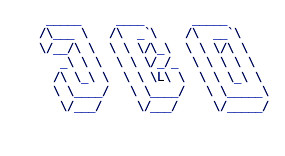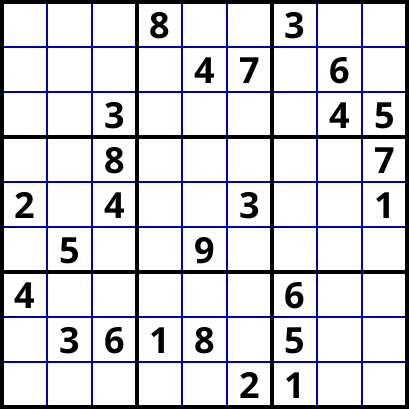

Welcome!
This is a place chosen to make available some ideas (on puzzles, patterns, etc)
that seemed unsuitable for posting in a Forum, but some people may find interesting.
For difficult puzzles, possible solutions will not be shown (only hints).
For other puzzles, the solution wil be hidden so that a serious attempt can be made
without direct access to a solution.
(hopefully this will make the puzzles more interesting for newcomers).
I propose this first (tough!) Classic Sudoku puzzle of the year.
This puzzle is solvable in just three krakenless steps.

(found with Sudoku Architect)
After basics
,---------------------------------------------------------,
| 4789 25679 25678 | 148 1268 1468 | 589 3 158 |
| 89 2569 23568 | 138 12368 7 | 589 159 4 |
| 48 1 38 | 348 9 5 | 6 2 7 |
|--------------------+-------------------+----------------|
| 1 247 27 | 6 5 34 | 237 8 9 |
| 6 8 9 | 7 13 2 | 4 15 135 |
| 3 2457 257 | 1489 18 1489 | 27 16 126 |
|--------------------+-------------------+----------------|
| 5 69 1 | 2389 7 3689 | 23 4 2368 |
| 2 3 4 | 1589 168 1689 | 589 7 568 |
| 789 679 678 | 2359 4 369 | 1 569 2356 |
'---------------------------------------------------------'
Update (Jan 5, 2026)
First thing to notice is the UR(27) c46g46. Either (5)c4, or
(3)g6 must be true. However, this does not seem to lead to anything
really useful
[only (5)c5 == (3)g6 - (3=4)f6 - (4)b6 = (4)b4 => -5 b4, with 1 placement].
So, we inspect the single digit patterns and bivalued cells (BVC).
The pattern on 3, 2 and 9, and the BVC (34)f6, (13)e5, (18)e4, (15)h5
are promissing. Indeed, these are the elements for an als-ahs
chain that eliminates (3)f6,
,---------------------------------------------------------,
| 4789 25679 25678 | 148 1268 1468 | 589 3 158 | 9
| 89 2569 23568 | 138 12368 7 | 589 159 4 | 8
| 48 1 38 | 348 9 5 | 6 2 7 | 7
|--------------------+-------------------+----------------|
| 1 247 27 | 6 5 4-3 | 237 8 9 | 6
| 6 8 9 | 7 13 2 | 4 15 135 | 5
| 3 2457 257 | 1489 18 1489 | 27 16 126 | 4
|--------------------+-------------------+----------------|
| 5 69 1 | 2389 7 3689 | 23 4 2368 | 3
| 2 3 4 | 1589 168 1689 | 589 7 568 | 2
| 789 679 678 | 2359 4 369 | 1 569 2356 | 1
'---------------------------------------------------------'
a b c d e f g h i
giving 11 placements and basic eliminations.
,--------------------------------------------------------------,
| 4789 25679 2678 | 148 1268 168 | 589 3 18 | 9
| 89 2569 2368 | 138 1268 7 | 589 19 4 | 8
| 48 1 38 | 348 9 5 | 6 2 7 | 7
|---------------------+---------------------+------------------|
| 1 27 27 | 6 5 4 | 3 8 9 | 6
| 6 8 9 | 7 3 2 | 4 15 15 | 5
| 3 4 5 | 189 18 189 | 7 6 2 | 4
|---------------------+---------------------+------------------|
| 5 69 1 | 89 7 3689 | 2 4 368 | 3
| 2 3 4 | 5 168 1689 | 89 7 68 | 2
| 789 679 678 | 2 4 369 | 1 59 356 | 1
'--------------------------------------------------------------'
a b c d e f g h i
How to proceed ?
Update (Dec 6, 2026)
The chain for move 1 used the almost hidden set (23)d1.i1:
,-----------------------------------------------------------,
| 4789 25679 25678 | 148 1268 1468 | 589 3 158 |
| 89 2569 23568 | 138 12368 7 | 589 159 4 |
| 48 1 38 | 348 9 5 | 6 2 7 |
|--------------------+--------------------+-----------------|
| 1 247 27 | 6 5 4-3 | 237 8 9 |
| 6 8 9 | 7 (13)----2----|-4-> (15) 135 |
| 3 2457 257 | 1489 18 1489 | 27 |16 126 |
|--------------------+--------------------+-----|-----------|
| 5 69 1 | 2389 7 3689 | 23 |4 2368 |
| 2 3 4 | 1589 168 1689 | 589 v7 568 |
| 789 679 678 |[235]9 4 (3)69 | 1 (5)69 [253]6|
'-----------------------------------------------------------'
For move 2, the available Y-wing is useful.
ADDED:
,--------------------------------------------------------------,
| 4789 25679 2678 | 148 1268 168 | 589 3 *18 | 9
|*89 2569 2368 | 138 1268 7 | 589 *19 4 | 8
| 48 1 38 | 348 9 5 | 6 2 7 | 7
|---------------------+---------------------+------------------|
| 1 27 27 | 6 5 4 | 3 8 9 | 6
| 6 8 9 | 7 3 2 | 4 15 15 | 5
| 3 4 5 | 189 18 189 | 7 6 2 | 4
|---------------------+---------------------+------------------|
| 5 69 1 | 89 7 3689 | 2 4 368 | 3
| 2 3 4 | 5 168 1689 | 89 7 68 | 2
| 789 679 678 | 2 4 369 | 1 59 356 | 1
'--------------------------------------------------------------'
a b c d e f g h i
The final move
is the most difficult one, solving the puzzle with lclste
(i.e., it does solve the puzzle with only basic moves to
the end, but these moves aren't just singles).
Update (Jan 7, 2026)
Moves 2 and 3 are independent, so they can be described using
the same configuration
,--------------------------------------------------------------,
| 4789 25679 2678 | 148 1268 168 | 589 3 18 | 9
| 89 2569 2368 | 138 1268 7 | 589 19 4 | 8
| 48 1 38 | 348 9 5 | 6 2 7 | 7
|---------------------+---------------------+------------------|
| 1 27 27 | 6 5 4 | 3 8 9 | 6
| 6 8 9 | 7 3 2 | 4 15 15 | 5
| 3 4 5 | 189 8-1 189 | 7 6 2 | 4
|---------------------+---------------------+------------------|
| 5 69 1 | 89 7 3689 | 2 4 368 | 3
| 2 3 4 | 5 168 1689 | 89 7 68 | 2
| 789 679 678 | 2 4 369 | 1 59 356 | 1
'--------------------------------------------------------------'
a b c d e f g h i
For move 3, the als (189)d34 is important. The goal is to show
that (1)e4 is false. This elimination solves the puzzle solves the
puzzle with lclste.
Next time, I'll describe another way for moves 2,3 [my first solution]
that gets singles to the end, but at the price of using almost chains.
The following Classic Sudoku puzzle has interesting constraints.
The puzzle is solvable in only one krakenless move.

(found with Sudoku Architect)
,------------------------------------------------------,
| 679 4 279 | 8 256 569 | 3 1 29 |
| 159 129 1259 | 3 4 7 | 289 6 289 |
| 689 2689 3 | 269 126 169 | 7 4 5 |
|------------------+------------------+----------------|
| 369 69 8 | 2456 1256 1456 | 249 2359 7 |
| 2 679 4 | 567 567 3 | 89 589 1 |
| 137 5 17 | 247 9 8 | 24 23 6 |
|------------------+------------------+----------------|
| 4 12 12 | 579 357 59 | 6 89 389 |
| 79 3 6 | 1 8 49 | 5 279 249 |
| 5789 789 579 | 46 36 2 | 1 79 34 |
'------------------------------------------------------'
Update (Dec 6, 2026)
. UR(12)bc3,bc8: it does not seem very helpful.
. DP (89)hi3,gh5,gi8: it does not seem to help either.
. Patterns of 3, 4 are very promissing, also due to
the BVCs involved: (3)i1 can be eliminate using these
features.
,------------------------------------------------------,
| 679 4 279 | 8 256 569 | 3 1 29 | 9
| 159 129 1259 | 3 4 7 | 289 6 289 | 8
| 689 2689 3 | 269 126 169 | 7 4 5 | 7
|------------------+------------------+----------------|
| 369 69 8 | 2456 1256 1456 | 249 2359 7 | 6
| 2 679 4 | 567 567 3 | 89 589 1 | 5
| 137 5 17 | 247 9 8 | 24 23 6 | 4
|------------------+------------------+----------------|
| 4 12 12 | 579 357 59 | 6 89 389 | 3
| 79 3 6 | 1 8 49 | 5 279 249 | 2
| 5789 789 579 | 46 36 2 | 1 79 4-3 | 1
'------------------------------------------------------'
a b c d e f g h i
However, the pattern of 7 is even better, since it allows
a solution in one step: -2 h2 and only singles afterwards.
(this was my step 2, already available for being step 1)
ADDED:
,------------------------------------------------------,
| 679 4 279 | 8 256 569 | 3 1 29 | 9
| 159 129 1259 | 3 4 7 | 289 6 289 | 8
| 689 2689 3 | 269 126 169 | 7 4 5 | 7
|------------------+------------------+----------------|
| 369 69 8 | 2456 1256 1456 | 249 2359 7 | 6
| 2 (7)69 4 | 567 567 3 | 89 589 1 | 5
|[137] 5 [17] | 247 9 8 | 24 [23] 6 | 4 ALS
|------------------+------------------+----------------|
| 4 12 12 | 579 357 59 | 6 89 389 | 3
| 79 3 6 | 1 8 49 | 5 (7)9-2 249 | 2
| 5789 (7)89 579 | 46 36 2 | 1 (7)9 34 | 1
'------------------------------------------------------'
a b c d e f g h i
Created: February 12, 2024
Contact: sudo.jco.br@gmail.com